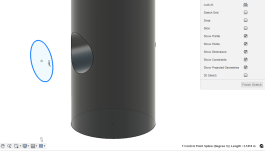Areo Defense
Aluminum
- Joined
- Apr 25, 2022
Sounds like you've handled this and your customer will accept the results.How do you guys deal with mediocre cad files… got some files that would actually be really good except they are full of splines and have some illegal boundaries.
They machine Ok and make a pretty good part but leave blemishes that can’t be eliminated without redoing the cad model. Things that should be easy like adjusting a radius are impossible and certain cutter paths don’t work or have lots of “spikes” on the CAM. Things that should be done with basic 3 axis cutter paths are 5 axis style cutter paths.
Is there an effective way to tell customers and engineers to STOP drawing with splines.
I tried explain this to the customer and even sent a dxf that will eliminate most of the problems but they will have to the 3D work.
I would bet the person who drew the model was inexperienced and his model shows it. For the record, it is sometimes not possible to avoid splines altogether when a line or arc won't do. It doesn't matter if the design is in Creo, NX or GeorgeCAD. It's still up to the engineer or designer to produce a good model. If a model is garbage then the parts will be garbage, so if model fixing is possible, that's where up-charges come in.




